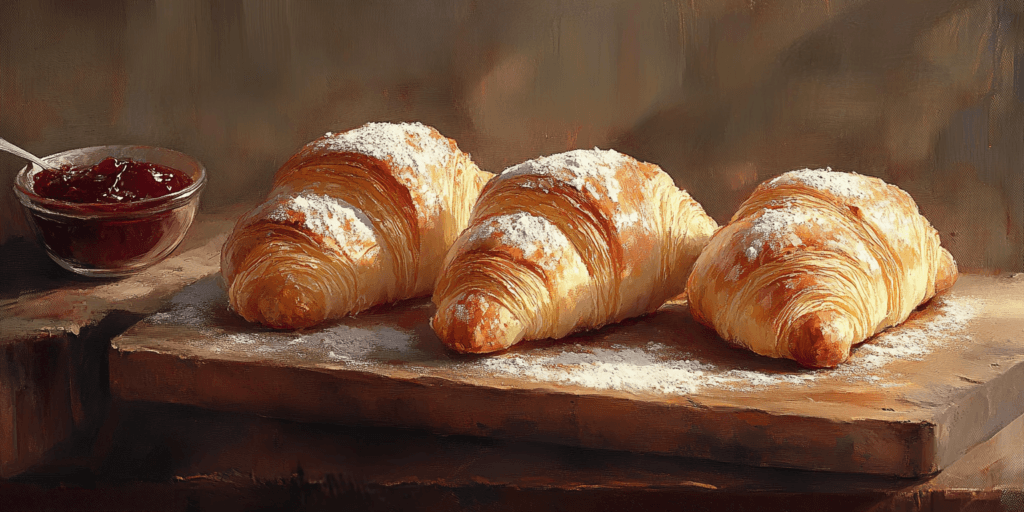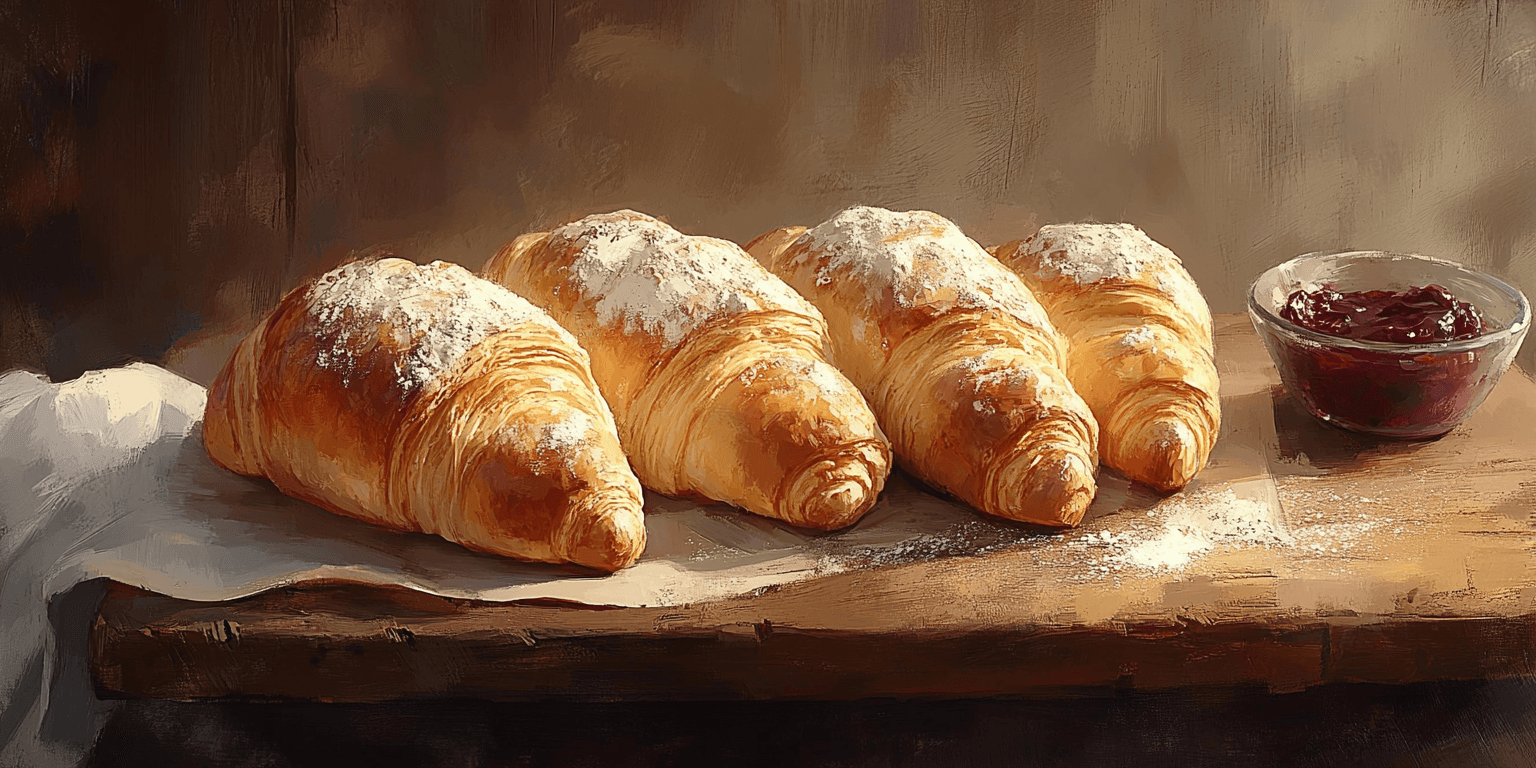Introduction to Gipfeli recipe: A Swiss Culinary Delight
Gipfeli, often recognized as the Swiss counterpart to the widely known croissant, is a staple in Swiss baking culture. Originating in Switzerland, this flaky, buttery pastry is favored for breakfast or as a delightful snack throughout the day. Distinct from croissants, Gipfeli are typically smaller and sport a more pronounced crescent shape, offering not just a taste sensation but also a feast for the eyes.
Essential Ingredients for the Perfect Gipfeli Recipe
To craft the perfect Gipfeli, starting with the right ingredients is crucial. Here’s what you’ll need:
- Flour: Serves as the foundation of the dough, with all-purpose or bread flour recommended for the best structure and chew.
- Yeast: Active dry yeast is essential to help the dough rise and develop its characteristic light, airy texture.
- Butter: Cold, unsalted butter is key to creating the laminated layers that give Gipfeli their fame.
- Milk and Sugar: Milk helps soften the dough, while sugar adds a hint of sweetness.
- Salt: Just a pinch enhances all the flavors in the dough.
For those with dietary restrictions, here are some adaptations:
- Gluten-Free Flour: Opt for a high-quality gluten-free flour blend for those with gluten sensitivities.
- Vegan Butter and Dairy-Free Milk: Plant-based butter and non-dairy milks like almond or soy can be used without compromising the texture.
These ingredients combine to form a dough that, with proper technique, bakes into the light, flaky pastries known as Gipfeli. To understand more about each ingredient’s role in baking, resources like King Arthur Baking – Croissant Making Tips and Serious Eats – Pastry Techniques offer in-depth insights.
Step-by-Step Gipfeli Recipe Guide: From Dough to Delight
Preparing the Dough:
- Activate the Yeast: Begin by mixing warm milk with a touch of sugar and yeast, allowing it to become frothy.
- Combine Ingredients: Sift flour, sugar, and salt together in a large mixing bowl, then blend in the activated yeast mixture.
- Knead the Dough: Gradually add pieces of cold butter while kneading until the dough is smooth and elastic.
Laminating the Dough:
- Roll and Fold: Roll the dough into a rectangle, layer with butter, and fold. Chill between folds and repeat several times to ensure multiple layers form.

For additional guidance on lamination and dough handling, Serious Eats – Pastry Techniques provides a comprehensive guide to achieving that perfect flaky texture. By integrating these steps and resources, your journey to mastering Gipfeli will not only enhance your baking skills but also bring a taste of Switzerland into your kitchen.
Enjoy your freshly baked Gipfeli with a hot cup of coffee or as part of a warm, inviting breakfast. These tips will help you achieve bakery-quality results in your home kitchen.
Shaping, Proofing, and Baking Gipfeli: A Comprehensive Guide
Creating perfect Gipfeli involves meticulous shaping, proofing, and baking processes. Below is an expanded guide on how to craft these delightful pastries, complemented by advanced baking tips to enhance your skills.
Shaping the Gipfeli
The shape of Gipfeli is iconic, and achieving it starts with properly prepared dough:
- Cut the Dough: Begin by rolling out the laminated dough into a thin, even layer. This dough should be smooth and elastic. Using a sharp knife or a pizza cutter, slice the dough into long, triangular strips. Each triangle will form the base of your Gipfeli.
- Roll the Triangles: Start at the wide base of each triangle, gently roll the dough towards the narrow tip. It’s important to roll tightly, but without squashing the dough, to maintain the layers you’ve created during lamination. As you reach the tip, tuck it underneath the rolled dough to secure the crescent shape. This prevents the pastries from unrolling during the proofing and baking stages.
Proofing the Gipfeli
Proofing is crucial as it allows the shaped dough to rise and develop flavor:
- Arrange for Proofing: Place the shaped Gipfeli on a baking sheet lined with parchment paper. Ensure they are spaced well apart to allow for expansion.
- Cover and Let Rise: Cover the Gipfeli lightly with a damp towel. This keeps the dough from drying out. Let them proof in a warm, draft-free area of your kitchen. Proofing typically takes 30-45 minutes but may vary depending on the ambient temperature. The Gipfeli are ready for the oven once they have puffed up and appear airy.
Baking the Gipfeli
Baking transforms the proofed dough into golden, flaky pastries:
- Preheat Your Oven: Ensure your oven is heated to 375°F (190°C). An accurate oven temperature is critical for even baking and achieving the golden crust Gipfeli are known for.
- Egg Wash for Shine: Before baking, brush each Gipfeli with an egg wash. This mixture, usually made of beaten egg with a little water or milk, gives the baked Gipfeli a rich, golden shine and enhances the flavor.
- Bake to Perfection: Place the baking sheet in the center of your oven to promote even heat distribution. Bake the Gipfeli for 15-20 minutes. Watch closely in the last few minutes to prevent over-browning. The Gipfeli are done when they have a deep golden brown color and the layers are visibly flaky.
Advanced Baking Tips
To further elevate your Gipfeli, consider the following advanced baking tips:
- Temperature Control: Managing the temperature of both your ingredients and the environment is crucial. Keep all ingredients, particularly butter, chilled until use. This prevents the butter from melting into the dough too early, which is essential for achieving the layered, flaky texture.
- Rolling Precision: When rolling out the dough, apply consistent and gentle pressure. Aim for uniform thickness to ensure that the pastries bake evenly.
- Accurate Proofing: Allow the dough to rise until it doubles in size. This not only improves the texture but also enhances the flavor of the Gipfeli. Be mindful of the proofing environment—too cold, and the dough won’t rise properly; too warm, and it may overproof.
- Butter Layering: Mastery of the lamination process is key. Fold and roll the dough meticulously to create numerous thin layers of butter and dough. These layers are what create the pastry’s characteristic flakiness.
- Chilling Stages: Between each set of folds, chill the dough in the refrigerator. This helps maintain the distinct layers of butter and dough, making the final texture of the Gipfeli lighter and flakier.
- Edge Sealing: When shaping, ensure that the edges of your Gipfeli are well-sealed. This helps them maintain their shape during baking and prevents the layers from separating.
- Baking Environment: Use an oven thermometer to ensure your oven is at the correct temperature. Variations in oven temperature can lead to uneven baking, affecting the texture and color of your Gipfeli.
By following these detailed steps and incorporating the advanced tips, you can master the art of baking Gipfeli. Whether enjoyed with a morning coffee or as a part of a lavish brunch, these Swiss pastries bring delight and satisfaction to any table. Continue to practice and refine your techniques, and each batch of Gipfeli will be better than the last, showcasing your skills and passion for baking.

Part 4: Expanded FAQs and Additional Resources on Gipfeli Recipes
Comprehensive FAQs About Gipfeli Recipes
In the world of baking, Gipfeli holds a special place, and bakers often seek detailed insights to perfect their craft. Here, we explore more about Gipfeli recipes and related culinary topics, providing deeper understanding through frequently asked questions:
- What are the nuanced differences between a croissant and a Gipfeli in a Gipfeli recipe?
Gipfeli recipes often result in pastries that are smaller and more crescent-shaped than traditional French croissants. They may also feature subtle variations in ingredients, impacting texture and flavor distinctly. For historical perspectives on these pastries, refer to trusted sources like the U.S. Library of Congress Food History Collections. - How is a croissant referred to in Switzerland, and how does this affect Gipfeli recipes?
Known as “Gipfeli” in Swiss German, this term reflects the pastry’s integration and adaptation within Swiss culinary traditions, which may influence local Gipfeli recipes. Detailed cultural insights can be found at Cultural Heritage Switzerland. - What ingredients make a Nussgipfel unique in Swiss Gipfeli recipes?
Nussgipfel, a delightful variant in Gipfeli recipes, includes a rich, nutty filling made from almonds, hazelnuts, and walnuts, mixed with honey or sugar—enhancing traditional Gipfeli recipes with hearty Swiss flavors. Learn more about Swiss ingredients from the Swiss Federal Office for Food Safety and Veterinary Affairs. - Could you describe a basic recipe for Mangria that complements a Gipfeli recipe?
Mangria, enhancing any Gipfeli recipe serving, is crafted by blending red wine with fruit juices, a dash of brandy, and fresh fruits like oranges and mangos. For safe preparation and serving suggestions, consult the U.S. National Institute on Alcohol Abuse and Alcoholism.
Enhanced Resources for Perfecting Your Gipfeli Recipe
To further refine your Gipfeli recipes and broaden your baking and culinary skills, consider these additional resources:
- Professional Baking Courses: Deepen your understanding of Gipfeli recipes through professional baking courses offered by institutions like the American Culinary Federation, which provide detailed training in pastry and baking techniques.
- Online Culinary Tutorials: Platforms such as YouTube are treasure troves of step-by-step tutorials that visually guide you through the precise techniques needed to perfect Gipfeli recipes. These visual aids are crucial for mastering complex baking tasks.
- In-depth Baking Books: Comprehensive baking books are invaluable for those looking to perfect their Gipfeli recipes. They offer not only recipes but also scientific insights into how ingredients interact, which is crucial for achieving the desired results in baking.
- Interactive Culinary Blogs and Forums: Engage with a community of baking enthusiasts on platforms like Reddit’s r/Baking, where you can exchange Gipfeli recipes, receive feedback, and find new baking inspiration.
- Exploration of Swiss Culinary Heritage: Enhance your understanding of Gipfeli recipes by exploring the rich culinary heritage of Switzerland through resources provided by the Swiss National Museum.
Conclusion
Mastering Gipfeli recipes offers a rewarding venture into the world of baking. Whether you are whipping up a batch for a family breakfast, showcasing them at a brunch, or enjoying the baking process, these Swiss pastries are sure to impress. Continue to refine your techniques, explore new variations, and most importantly, enjoy every bite of your delicious creations. Utilize these resources to ensure every Gipfeli recipe you try is a success, and delight in the pleasures of baking.

